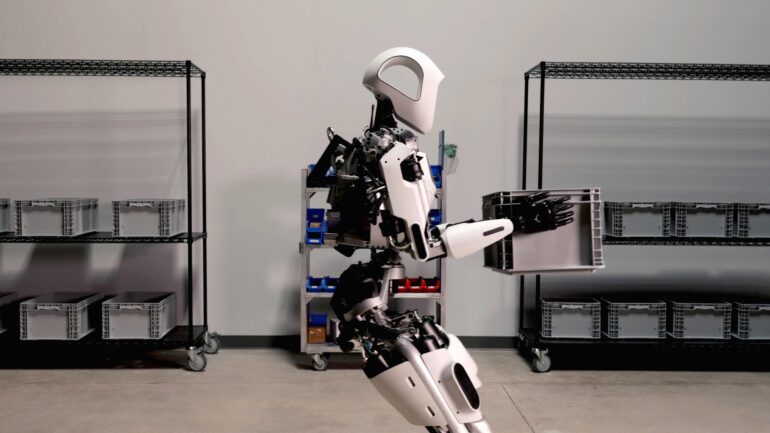TL;DR:
- Apollo, a new humanoid robot, blurs the lines between AI and human collaboration.
- Created by Apptronik, Apollo stands at 5’8″ and weighs 160 lbs, designed for human-like interaction.
- A versatile robot, Apollo can work alongside humans and in hazardous environments, transforming industries like logistics, manufacturing, and more.
- Apptronik’s CEO, Jeff Cardenas, envisions Apollo utilizing evolving AI models for cognitive and physical tasks.
- The cost-effective platform allows customization beyond the base model.
- Apptronik introduced “Robots as a Service” (RaaS), enabling customers to lease Apollo robots and pay based on operational hours.
- While concerns about job displacement persist, Cardenas sees Apollo as a solution to labor shortages in critical industries.
- Similar to generative AI, Apollo seeks to augment human abilities rather than replace them.
Main AI News:
The fusion of humanoid robotics and artificial intelligence has ignited a blend of awe and apprehension within the tech landscape. The fascination stems from envisioning sci-fi-like automatons, yet it’s accompanied by concerns over potential job displacements and their broader ramifications.
Key luminaries in the tech domain, such as Amazon’s visionary Jeff Bezos and Tesla’s maverick Elon Musk, have been entranced by this concept. Bezos orchestrates an annual robotics symposium, while Musk’s brainchild, Optimus, aspires to outnumber humans, as he boldly asserts. Although Musk’s prediction remains distant, a new entrant, named Apollo, has now graced the public arena, pushing us further into the realm of the robotic epoch.
This groundbreaking robot, dubbed Apollo, stands at a humanesque 5 feet 8 inches and weighs 160 pounds, meticulously designed to exude a relatable and personified aura. Crafted by the innovators at Apptronik, based in Austin, Apollo aims to be a versatile collaborator, seamlessly integrating with human counterparts and even potentially superseding them in hazardous work environments.
Initially tailored for tasks such as case and tote handling in sectors like logistics and manufacturing, Apollo serves as an all-encompassing robotic platform. Its applications span across diverse industries like construction, oil and gas, electronics production, elder care, retail, and home delivery. This versatility traces its origins back to the DARPA Robotics Challenge, where Apptronik’s founders collaborated with NASA Johnson Space Center on the Calgary robot. Subsequently, the company emerged from the University of Texas at Austin’s Human Centered Robotics Lab, birthing Apptronik.
Jeff Cardenas, the CEO of Apptronik, affirms their journey of refining robotics for over seven years, birthing numerous iterations from mobile robots to humanoid counterparts. Cardenas elaborates on Apollo’s artificial intelligence facets, categorizing them into cognitive intelligence, governing decision-making, and physical intelligence, which encompasses actions as innate as balancing and hand-eye coordination. He envisions Apollo embracing evolving AI models, emphasizing their importance for a truly versatile general-purpose robot.
A distinctive facet of Apollo’s allure is its cost-effectiveness, which is expected to undercut the prices of several car models. However, this is merely the foundational investment, as customers are encouraged to tailor Apollo to their distinct requisites.
Notably, Apptronik is pioneering an alternative business model – Robots as a Service (RaaS). This innovative approach entails leasing Apollo robots and remunerating them on a monthly basis commensurate with their operational hours. This model, analogous to employer-employee dynamics, raises concerns about job scarcity. Yet, Cardenas contends that Apollo is a solution to workforce shortages in critical sectors, redirecting humans toward tasks aligned with their aptitudes.
This paradigm shift echoes the discourse surrounding generative AI. Just as AI promises to liberate creative minds from mundane tasks, Apollo offers to alleviate the toil of manual labor. While skeptics foresee a future marred by job erosion, the potential to enhance work environments and refocus human skills remains palpable.
The impending integration of robots like Apollo into the workforce beckons fascinating deliberations. From labor dynamics to healthcare provisions, from work hours to job availability, the transformation is poised to be intricate and multifaceted. Cardenas evokes comparisons to pivotal historical junctures, akin to the advent of personal computers, urging society to embrace change despite apprehensions.
Indeed, the conversation extends beyond a binary human-robot substitution. The impending shifts could breed novel employment and reshape our work culture, provided we navigate this evolution with sagacity. In this voyage of transformation, it’s imperative to recognize that multifarious predicaments warrant an array of solutions.
Conclusion:
Apollo’s introduction marks a pivotal moment in the synergy between robotics and AI. The cost-effective, versatile, and collaborative nature of Apollo, along with the innovative RaaS model, could potentially reshape labor dynamics across industries. The prospect of heightened efficiency, reduced risk, and the augmentation of human capabilities underlines a promising trajectory for the market, albeit with necessary discussions around job displacement and societal change.

